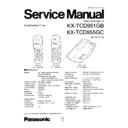Panasonic KX-TCD951GB / KX-TCD955GC Service Manual ▷ View online
25
KX-TCD951GB/KX-TCD955GC
Circuit Diagram
Fig. 20
Tx-AF
Rx-AF
DAC
CODEC
ADC
B.M.C.
GAUSS FILTER
DTMF GENERATOR
RSSI ADC
CLOCK/DATA
RECOVERY
RECOVERY
26
KX-TCD951GB/KX-TCD955GC
2. THE LINE INTERFACE SECTION (SEE BLOCK DIAGRAM Fig. 18)
2.1 INTRODUCTION
This section consists of the telephone line interface, bell detector, charge-pulse detector, hook switch, pulse dialing
circuits, audio circuits, DC mask & line impedance circuits, power supplies, and battery charger circuits.
2.2 TELEPHONE LINE INTERFACE (SEE Fig. 21)
The telephone line is connected (via 2 or 3 jumpers selected for country of destination) to a JMP19 and JMP20. Surge
suppressor SA3 protects against excessive line voltages. Test points are TP14 (A), TP13 (B), TP21 (S) and TP15 (E).
A 16 kHz notch filter L3, L5, C5 and C26 blocks the 16 kHz “charge pulse” signal from the rest of the line input cir-
cuitry.
Bridge rectifier D8 provides for lines of either polarity. The output of D8 is “Line +” (TP39) and “Line –” which is ground.
2.3 EARTH RECALL (SEE Fig. 21)
For countries that require Earth Recall facilities, relay RLY1 is provided to short the E line to the A or B lines. The relay
is energized when transistor T2 is switched on by a high level on the EARTH control line from the BB-IC IC101. D1
will quench the large back-emf voltage that would otherwise occur across the relay coil when T2 turns off.
2.4 BELL DETECTOR (SEE Fig. 21)
The AC ringing signal is detected by optocoupler IC2, using its internal diode in conjunction with D4. DC from the line
is blocked by C2. The other components D2, D3, and R3 reduce current and increase the circuit impedance in line with
national requirements. When ringing is detected IC2 will turn on, and the RING line will be dragged to a low voltage.
Fig. 21
REV-POL
LINE-SENS
TP23
TP24
Circuit Diagram
27
KX-TCD951GB/KX-TCD955GC
Fig. 22
Circuit Diagram
2.5 CHARGE PULSE DETECTOR (SEE Fig. 21)
The 16 kHz charge pulse (billing pulse) signal is detected by IC3A, which forms a sharp 16 kHz bandpass filter. If a
16 kHz charge pulse is present, a large 16 kHz output from IC3A will switch comparator IC3B, which output a 16 kHz
square wave. This will cause transistor T18 to switch, sending the 16 kHz square wave signal CHARGE-PULSE to the
BBIC. The BBIC will check the frequency and pulse length to determine if it is a valid charge pulse.
2.6 CLIP CIRCUITS (SEE Fig. 21)
The caller ID signal is detected by IC4.
2.7 HOOK SWITCH (AND PULSE DIALING) (SEE Fig. 22)
T8 is the hook switch, driven by T9. When the phone is “off-hook”, the HOOK control signal from the BBIC will be a
high logic level (+3V), and both transistors will be on, thus T8 will “loop” the line. The zener diode D10 protects transis-
tors T11 to T13 against transient line voltages.
2.8 PULSE DIALING (SEE Fig. 22)
During pulse dialing the hook switch (T8, T9) is used to generate the pulses using the HOOK control signal, which is
set high during pulses. To force the line impedance low during the “pause” intervals between dial pulses,
the PAUSE-DIAL signal turns on T11, which turns on T12 harder (increases current).
2.9 AUDIO CIRCUITS (SEE Fig. 22)
The line output signal from the BBIC RXAF (TP120) is amplified by T13. The RXAF line is DC coupled to T13 thus
making it work as a current limiter (typically < 8mA). The emitter load of T13 is complex to achieved the correct fre-
quency response, since the line load (for Germany) is also complex.
The line input signal TXAF (TP123) is taken from the junction of R41 and R70. Phase cancellation of the line output
audio occurs at this point, so that only incoming line audio should be passed to the BBIC on TXAF.
RxAF
TxAF
HOOK
PULSE DIAL
28
KX-TCD951GB/KX-TCD955GC
2.10 POWER SUPPLIES (SEE Fig. 23)
The AC Adaptor for the KX-TCD951GB/KX-TCD955GC consists of two separate isolated DC supplies providing a
+8 V supply for the base circuitry, and a 9 V supply only for the charger circuit. The isolation is because the main base
circuitry is connected to the telephone line, so potentially hazardous voltages may be present, while the charger
circuitry has charge contacts that could be touched by the operator, so the two supplies must be kept separate.
The 8 V supply from the AC Adaptor is connected via J2 pin 1 (TP90) +8 V, and J2 pin 2 (TP89) ground.
The unregulated +8 V supply is fed to the first regulator.
This regulator IC7 provides a regulated output pin 2 (TP91) of +4.0 V (called +4V).
The second regulator IC6 is fed with +4V and provides the stable +3.0V supply (TP95). During power-up this
regulator generates a RESET signal (TP94) which is used to reset the microcontroller and BBIC.
2.11 BATTERY CHARGER (SEE Fig. 23)
The 9 V supply from the AC Adaptor is connected via J2 pin 6 (TP82) positive, and J2 pin 5 (TP78) negative. The
constant current battery charger circuit is made up of T14 and T15 (series pass transistor) and associated
components. Charging detector circuit T16 switches on when a charging current flows through R64 and D11, and
turns on the “Charging” LED D12. The charge contacts are J3 (TP89) positive and J4 (TP88) negative.
Charge current flows in via J4, through T15, R63, AC Adaptor 9 V supply, R64, D11, and out via J3.
Circuit Diagram
VUNREG
RESET
Fig. 23
Click on the first or last page to see other KX-TCD951GB / KX-TCD955GC service manuals if exist.

